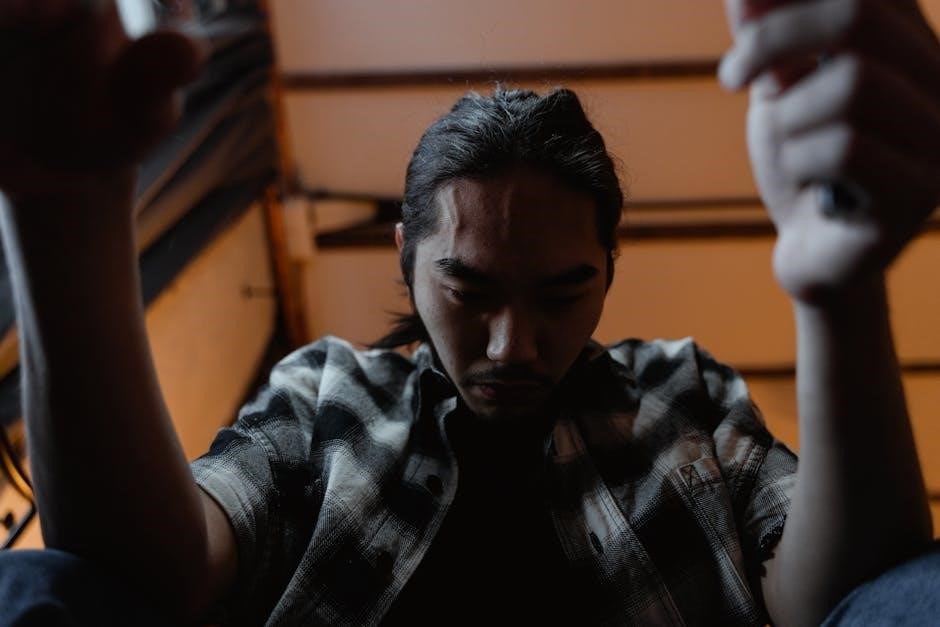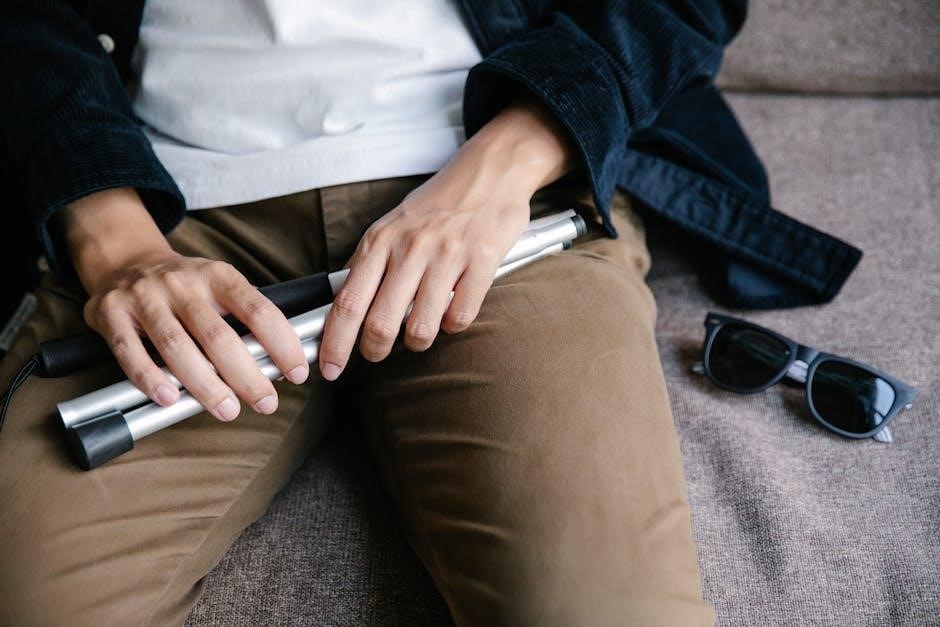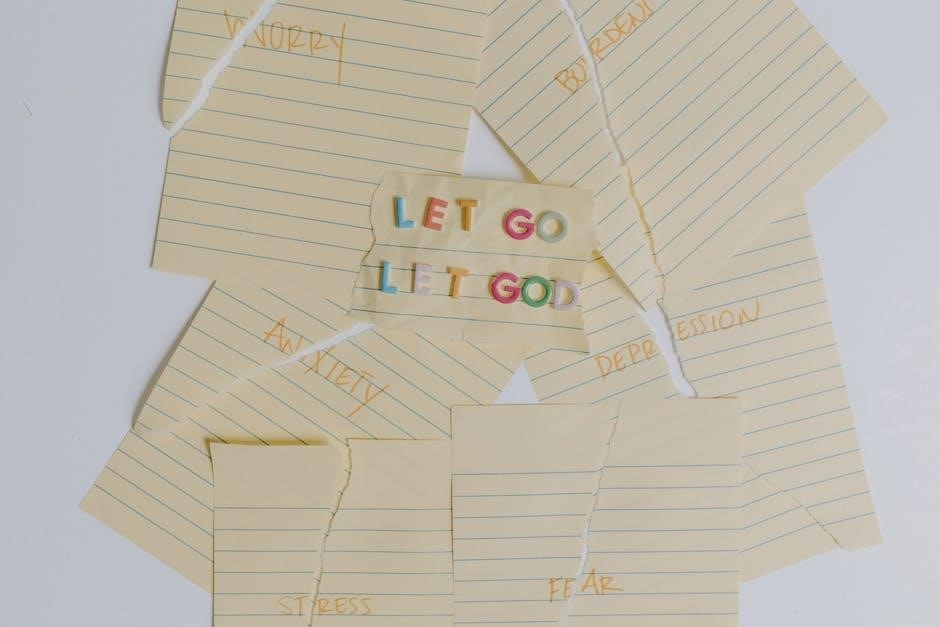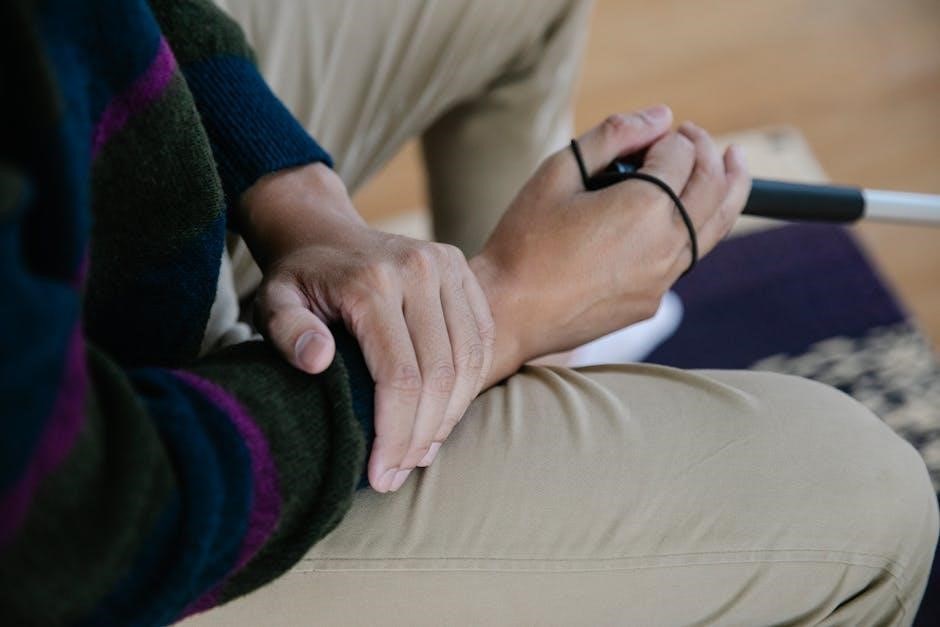Understanding Internalized Homophobia
Internalized homophobia occurs when individuals absorb societal homophobic views, leading to self-hatred and shame. It develops through exposure to heteronormative cultures and discriminatory environments, deeply impacting mental health and self-acceptance.
Definition and Overview
Internalized homophobia refers to the absorption of societal homophobic attitudes, leading individuals to harbor negative feelings about their own sexual orientation. It manifests as self-hatred, shame, and rejection of one’s identity. This psychological phenomenon develops when individuals internalize discriminatory messages, viewing themselves through the lens of heteronormative and prejudiced cultural norms. It is distinct from external homophobia, as it involves personal acceptance of oppressive beliefs, creating a deeply ingrained conflict with one’s true self. This internal struggle often results in emotional distress and mental health challenges.
How Internalized Homophobia Develops
Internalized homophobia develops when individuals are repeatedly exposed to homophobic messages, societal heteronormativity, and discriminatory cultural norms. Growing up in environments where homosexuality is stigmatized or invisible, people may internalize these negative views, leading to self-doubt and shame. Family, religious, or community rejection further solidifies these feelings, causing individuals to view their sexual orientation as flawed or unacceptable. Over time, this internalized hatred becomes a deeply ingrained belief, shaping self-perception and behavior in harmful ways.

The Psychological Impact of Internalized Homophobia
Internalized homophobia fosters self-hatred, leading to mental health struggles like depression and anxiety. It can also manifest as substance abuse, used as a coping mechanism for unresolved shame.
Shame and Self-Hatred
Internalized homophobia often manifests as deep-seated shame and self-hatred, stemming from the absorption of societal homophobia. This emotional burden can lead to self-loathing, self-doubt, and a distorted self-image. Individuals may struggle to accept their true selves, fearing rejection and judgment. This internalized shame can result in self-destructive behaviors, emotional distress, and difficulty forming healthy relationships. It also perpetuates a cycle of self-rejection, making it challenging to embrace authenticity and self-worth in a heteronormative and often unforgiving world.
Mental Health Consequences
Internalized homophobia is closely linked to severe mental health issues, including depression and anxiety. The emotional turmoil can escalate into self-destructive behaviors, such as substance abuse or self-harm, as individuals struggle to cope with their internal conflict. These feelings of shame and self-loathing often intensify without proper support, leading to a higher risk of suicidal thoughts or social withdrawal. Addressing these mental health consequences requires compassionate care and understanding, emphasizing the importance of early intervention and supportive systems to foster healing.

The Role of Societal and Cultural Norms
Societal and cultural norms often foster heteronormativity, perpetuating homophobic views that individuals internalize, leading to self-hatred, mental health struggles, and emotional pain.
Heteronormativity and Its Effects
Heteronormativity ingrains the belief that heterosexuality is the norm, marginalizing LGBTQ+ individuals. This societal conditioning leads to internalized homophobia, fostering self-doubt, low self-esteem, and fear of rejection. By perpetuating rigid gender roles and expectations, heteronormativity discourages authenticity, causing individuals to hide their true selves. The effects are profound, contributing to mental health struggles and a distorted self-perception, which can manifest as shame, anxiety, and depression. Breaking free from these norms is crucial for embracing one’s authentic identity and achieving self-acceptance.
The Influence of Media Representation
Media representation plays a significant role in shaping perceptions of LGBTQ+ individuals. Positive portrayals in films, TV shows, and literature can foster acceptance and reduce internalized homophobia by showcasing diverse, authentic stories. Conversely, negative or stereotypical depictions reinforce harmful stereotypes, contributing to self-shame and mental health struggles. Lack of representation exacerbates feelings of invisibility and isolation. Therefore, inclusive media is crucial for promoting self-acceptance and challenging societal norms, helping individuals overcome internalized homophobia and embrace their true identities with confidence and pride.

Recognizing the Signs of Internalized Homophobia
Signs include self-doubt, fear of rejection, and hiding one’s true identity due to societal homophobic views, leading to feelings of shame and low self-esteem.
Self-Doubt and Low Self-Esteem

Internalized homophobia often manifests as persistent self-doubt and low self-esteem, where individuals question their worth and struggle to accept themselves. This stems from internalizing negative societal messages, leading to a distorted self-perception. Such feelings can hinder personal growth and relationships, as the person may feel unworthy of love or acceptance. Addressing these emotions requires acknowledging their roots and actively working to reframe self-image through self-compassion and support.
Fear of Being “Out” and Rejection
Fear of being “out” and rejection is a common manifestation of internalized homophobia. Many individuals hide their true selves to avoid societal judgment or rejection, leading to emotional distress. This fear stems from internalized homophobic messages, making it difficult to embrace authenticity. The anxiety of being discovered or ostracized can prevent individuals from forming meaningful connections or seeking support, further isolating them. Addressing this fear requires building self-acceptance and creating safe spaces for open expression, helping individuals overcome the grip of internalized shame and societal expectations.

The Connection Between Internalized Homophobia and Mental Health
Internalized homophobia is closely linked to mental health issues, including depression, anxiety, and substance abuse. It stems from self-hatred and societal rejection, causing emotional distress and low self-esteem.
Depression and Anxiety
Internalized homophobia often manifests as depression and anxiety, rooted in self-hatred and societal rejection. Individuals may struggle with emotional distress, low self-esteem, and feelings of inadequacy. Studies show a strong correlation between internalized homophobia and mental health issues, with many experiencing chronic sadness, social withdrawal, and heightened anxiety levels. These struggles can intensify without support, making it crucial to address these emotional wounds through therapy and self-compassion. Recognizing these patterns is the first step toward healing and reclaiming one’s authentic self.
Substance Abuse and Coping Mechanisms
Internalized homophobia often leads to substance abuse as individuals seek to escape emotional pain and self-hatred. Drugs and alcohol become coping mechanisms to numb feelings of shame and rejection. This cycle can worsen mental health, creating a vicious loop of self-destructive behaviors. Studies link internalized homophobia to higher rates of substance abuse, emphasizing the need for addressing root causes. Seeking healthier coping strategies, such as therapy and support networks, is crucial for breaking this cycle and fostering emotional resilience.

Strategies for Overcoming Internalized Homophobia
Strategies include seeking therapy, building supportive networks, and practicing self-compassion. These approaches help individuals reclaim their identity, challenge harmful beliefs, and foster resilience against societal pressures.
Seeking Therapy and Professional Help
Seeking therapy is a crucial step in overcoming internalized homophobia. Trained therapists can provide a safe space to explore feelings of shame and self-hatred, helping individuals challenge harmful beliefs. Cognitive-behavioral therapy (CBT) and psychodynamic approaches are effective in addressing these issues. Professionals can also help individuals develop coping strategies and work through past traumas. Finding a therapist who specializes in LGBTQ+ issues ensures a deeper understanding of the unique challenges faced. Therapy fosters self-acceptance and resilience, empowering individuals to embrace their authentic selves.
Building a Support Network
Building a supportive network is vital for overcoming internalized homophobia. Connecting with understanding friends, family, or LGBTQ+ communities can provide validation and acceptance. Joining support groups or online forums allows individuals to share experiences and feel less isolated. Allies play a crucial role in offering encouragement and challenging homophobic attitudes. A strong support system helps counteract societal negativity, fostering resilience and self-acceptance. Surrounding oneself with loving and affirming people creates a safe environment for healing and growth.
Practicing Self-Compassion and Self-Acceptance
Practicing self-compassion and self-acceptance is crucial for healing from internalized homophobia. This involves acknowledging and challenging negative self-perceptions while embracing your authentic identity; Mindfulness and self-kindness can help reframe harmful beliefs. Journaling or affirmations may aid in building self-worth. Recognizing that your value isn’t tied to societal expectations fosters resilience. Embracing your true self, without judgment, is a powerful step toward liberation and mental well-being. Self-compassion allows you to heal and grow, replacing shame with love and acceptance.

The Importance of Community and Allies
Community and allies play a vital role in combating internalized homophobia by providing acceptance, support, and advocacy. They help create safe spaces for self-expression and empowerment.

Role of LGBTQ+ Communities
LGBTQ+ communities provide acceptance, understanding, and solidarity, helping individuals overcome internalized homophobia. They create safe spaces for sharing experiences, fostering empowerment, and promoting self-acceptance. By offering support networks and resources, these communities enable individuals to challenge societal norms and embrace their authentic selves. Allies within these communities further amplify acceptance, advocating for inclusivity and combating stigma. Their collective efforts foster resilience and healing, empowering individuals to reject internalized shame and thrive with confidence and pride.
How Allies Can Make a Difference
Allies play a vital role in combating internalized homophobia by actively supporting LGBTQ+ individuals and challenging societal norms. They amplify marginalized voices, promote inclusivity, and foster acceptance. Allies can educate themselves about LGBTQ+ issues, advocate for equality, and stand against discrimination. By offering emotional support and validation, they help individuals rebuild self-esteem and embrace their authenticity. Allies’ active involvement creates safer, more inclusive environments, empowering LGBTQ+ individuals to heal from internalized shame and thrive confidently.

Addressing Internalized Homophobia in Different Contexts
Internalized homophobia varies across religious, cultural, and familial settings, requiring tailored approaches to challenge deeply rooted beliefs and foster acceptance in diverse environments.
Religious and Spiritual Challenges
Religious teachings often perpetuate internalized homophobia by condemning same-sex relationships, leading to profound guilt and self-rejection. Many individuals struggle to reconcile their faith with their sexual identity, facing spiritual conflict. Some religious communities reinforce heteronormativity, while others offer inclusive perspectives. Navigating these challenges requires a balancing act between spiritual beliefs and personal authenticity. Supportive spiritual leaders and affirming religious groups can play a crucial role in helping individuals heal and integrate their faith with their identity, fostering self-acceptance and reducing internalized homophobia.
Cultural and Familial Expectations
Cultural and familial expectations often exacerbate internalized homophobia, particularly in communities with rigid gender roles and traditional values. Many individuals face pressure to conform to heteronormative norms, leading to feelings of inadequacy and self-rejection. Family rejection or conditional acceptance can deepen internalized shame, making it difficult to embrace one’s authentic identity. Addressing these challenges requires navigating complex emotional landscapes while seeking supportive environments that validate LGBTQ+ experiences and promote self-acceptance.
Overcoming internalized homophobia is a journey of self-compassion, healing, and embracing authenticity. Through therapy, support networks, and personal growth, individuals can break free from shame and foster self-love.
Embracing Your Authentic Self
Embracing your authentic self involves rejecting internalized homophobic beliefs and loving your true identity. This journey requires self-compassion, acceptance, and courage to challenge societal norms. By letting go of shame, individuals can align with their true selves, fostering confidence and resilience. Surrounding oneself with supportive communities and allies amplifies this process, creating a safe space for growth and healing. Authenticity is the cornerstone of overcoming internalized homophobia, leading to a fulfilling and empowered life.
A Path to Healing and Self-Love
Healing from internalized homophobia involves a journey of self-discovery and acceptance. Seeking therapy and support networks can provide tools to challenge harmful beliefs. Practicing self-compassion helps replace shame with kindness and understanding. Embracing one’s true identity fosters resilience and confidence. Surrounding oneself with affirming communities and allies further aids in the healing process. This path requires patience and courage but ultimately leads to self-love and empowerment, allowing individuals to live authentically and thrive beyond the confines of societal expectations. It is a transformative journey toward wholeness and peace.